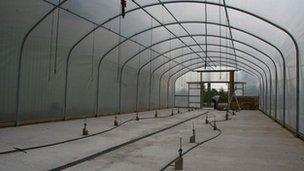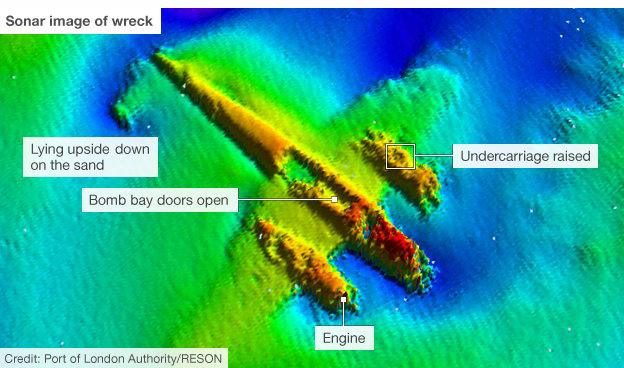German Dornier 17 salvage hit by English Channel weather
- Published
Nick Higham explains the new scheme for lifting the Dornier
A plan to raise the only surviving World War II Dornier 17 bomber from the English Channel has run into difficulties due to bad weather.
Experts salvaging the German aircraft, which is lying in 50ft of water at Goodwin Sands, off the Kent coast, have had to ditch their original strategy.
A faster but riskier approach will now take place.
The project has been likened to a modern Mary Rose, the famous Tudor warship raised from the Solent in 1982.
The original scheme to bring up the Dornier 17 - devised by the RAF Museum - was to build an aluminium frame or cradle around the wreck in which to lift it - putting the least possible strain on the fragile aircraft.
Divers were expected to take about three weeks to construct the frame, working down on the sea floor.
But ever since a salvage barge, complete with giant crane, arrived over the wreck site on the afternoon of 3 May, work has been repeatedly interrupted by bad weather.
Ian Thirsk, RAF Museum: "We need to get the aircraft raised within the next week"
Time pressure
Fifteen days of diving have been lost and the barge has had to take shelter in the harbour at Ramsgate, Kent on four occasions.
What is more, the salvage team discovered that the wreck, which was thought to be resting entirely on sand and silt, was in fact partly lying on chalk bedrock.
To put the lower struts of the frame in place, divers were having to drill painstakingly through the chalk rather than simply sliding the frame's components through soft sand.
Last week the museum and the specialist diving company doing the work, Seatech, held a crisis meeting.
The budget of more than £500,000 allowed 35 days to complete the project.
Continuing with the original plan would, they estimated, take 50 days - longer if the bad weather returned - and would cost tens of thousands of pounds more.
The RAF Museum told Seatech to adopt a revised plan which involves attaching cables at three points to the aircraft itself - exactly what the experts had hoped to avoid.
All three points are on the strongest part of the airframe - two single-section spars that run the length of both wings.
Since the plane is lying on its back, one cable will pass through its central bomb bay, with the other two running through the undercarriage doors next to the engines on either wing.
'No choice'

Two polytunnels have been set up at Cosford, where hoses will spray the Dornier with a citric acid solution
The tail of the wreck will also be supported during the lift, and a central beam will be inserted to run from the bomb bay doors back towards the tail section to give the fuselage extra strength.
Divers have discovered that a crack running around a third of the circumference at the point where the fuselage joins the wings has widened in the past two years.
"We're having to rely to a larger degree than we originally planned on the structural integrity of the aircraft," said Ian Thirsk, the RAF Museum's head of collections.
"But we have no choice. We're doing what we can to save a unique and precious heritage asset. If we leave it one thing is certain - it won't be there in a year's time."
The museum is hoping to put the new plan into practice next week, weather permitting.
The Dornier 17 was a mainstay of the German bomber fleets during the Battle of Britain in 1940.
The plane on the Goodwin Sands is believed to be aircraft call-sign 5K-AR, shot down on 26 August that year at the height of the battle by RAF Boulton-Paul Defiant fighters.
If the wreck is successfully raised the RAF Museum plans to transport it by road to its conservation centre at Cosford in the West Midlands, where it will spend more than 18 months being drenched in a solution of water and citric acid to stabilise it and prevent corrosion of the plane's aluminium structure.
It will then go on display at the museum's main base at Hendon in North London.

The original strategy would have led to time delays and increased costs for the project
- Published4 May 2013
- Published8 May 2013
- Published4 May 2013
- Published30 May 2013